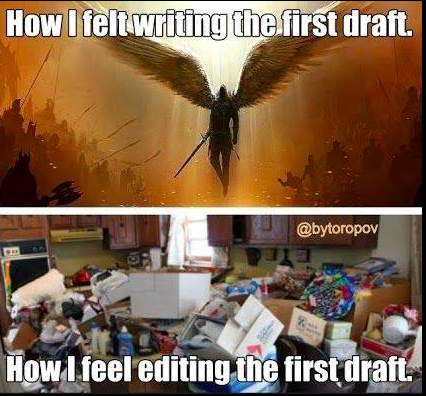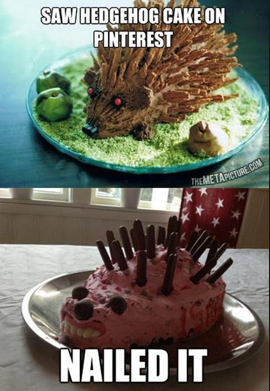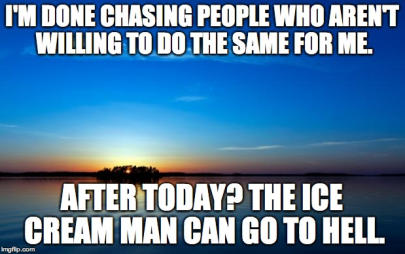So You Wrote a First Draft—Dear God! What NOW?

Once we have that crappy first draft usually there will be two major things we need to do…fill or cut. Okay, drinking makes three. And maybe wondering why we didn’t go to dental hygienist school instead makes four….
Anyway.
While it is true that too little substance can generate confusion, too much fluff can create distraction.
There needs to be a balance between…
Enough about the damn snowstorm! and Wait? There was snow?
Thus, once we have that completed first draft and begin our read-through we need to make these refinements to see if what we created meets or exceeds our expectations.
Sadly this is usually the first draft.

Much of what we will need to do is going to be dictated by what kind of writer we are. Are we a Trimmer or an Embellisher? There is a fantastic post over on Writer Unboxed that describes these two types of writers.
Some writers do a very sparse first draft that acts a lot like a frame for paper machet. It is really meant to just give an idea of the final form and serve as a guide.

Image via Flickr Creative Commons courtesy of Suzette.
Once the structure is inspected and found to be solid enough for government work, the writer then goes back through and fleshes in the work.
Other writers write super heavy then carve away what doesn’t serve the story.
And while I think all of us will identify with one type or another (Trimmer or Embellisher) it really helps to know what to add and/or what to cut.
If we add too much of the wrong thing, we can spoil the entire novel. If we cut too much of the right stuff we can collapse the story. Thus I hope today to at least give you some guidance beyond the more surface line-edit tips I’ve given before (6 Ways to Self-Edit and Polish Your Prose) though those are super helpful as well.
When I do a content edit for any writer, these are the main areas I am looking for.
What To Cut

Image via Flickr Creative Commons, courtesy of Jojo Nicado
Character Redundancy
Each character should have a distinctive personality. This personality will give them a corresponding unique purpose to driving the story forward and generating conflict.
In Lord of the Rings the main story problem is of course created by Sauron (the whole evil ring thing). But, much of the story conflict is actually created by the cast members of the various parties who all have a specific role to play.
Merry and Pippin create a lot of chaos that generates sudden changes in the plan. For instance, the plan was to meet Gandalf at The Prancing Pony NOT to nearly fall into the Dark Rider’s lap outrunning a ticked off farmer.
The duo is naive, inquisitive and we can kind of bundle them into one because they are a team in their mischief. To have essentially another Merry and or Pippin type character would be a redundancy that would be a distraction.
Ask yourself then: Do I have any characters who could be merged?

Image via Flickr Creative Commons courtesy of Q Family
Scenes that Don’t Move the Story Forward
All scenes have one common element. Conflict. There is a goal. No goal and that isn’t a scene.
Sections of information dump, flashbacks that have no ties to the main plot problem/resolution, or scenes with no conflict (I.e. two characters merely talking about a third character)? CUT.
Lackluster Description
Many of us love description. I do. My motto? No metaphor left behind! But description can have two main problems. Either we have a lot of good description but it is SO much that it is bogging down the story. Or, we have description, but it isn’t anything remarkable and we need to replace it with something better.
Ideally, it will be description that goes below the surface and adds to the plot, sets the tone and heightens tension.
Description is more than a weather report or a police sketch.
He was tall and handsome with a chiseled chin and dark wavy hair and…
And he took your purse?
I love this line from the beginning of Prisoner of Hell Gate, which is a literary suspense and one of my favorite books. This description hooks me and sets my expectations:
Dampness prevails, as always, but at this time less from the river and more from the mugginess that weighs on everything. It penetrates the very bricks, their crumbling mortar spongy to the touch.
I don’t know about you, but I am practically wilting reading this. It works way better than:
She walked beside the river on a hot summer night.
Though obviously style will dictate how we write description, even lean writers use words that will give the most impact.
He was a boring man dressed in an off-the-rack suit.
Maybe, instead…
He was the kind of man whose face you forgot even while you were still speaking to him.
Good description is less about piling on details and more about evoking a feeling.
What to Add
Sense of Time and Place
Is this a modern story? Or one set back in time? Is there magic? Technology? What is the setting? Now drop in the details that ground us. Talking heads in a place we aren’t oriented in is jarring. If this is in the beginning of a book, often it will fail to hook.

Character Nuance
If we just roughed out a bare-bones plot, we now need to go put the modeling clay on the skull.
Another one of my all-time favorite books is Rot & Ruin by Jonathan Maberry. Now in a parallel world maybe he just wrote out that he needed “a brash bounty hunter with a red car” then later built it into this:
“It was a 1967 Pontiac LeMans Ragtop. Bloodred and so souped-up that she’d outrun any damn thing on the road. And I do mean damned thing.”
That’s how Charlie Matthias always described his car. Then, he’d give a big braying horselaugh, because no matter how many times he said it, he thought it was the funniest joke ever. People tended to laugh with him rather than at the actual joke, because Charlie had a 72-inch chest and 24-inch biceps, and his sweat was a soup of testosterone, anabolic steroids, and Jack Daniels… (Page, 24)
We learned a lot about this character from a three-sentence bit of dialogue, some power-packed description and even some narrative regarding how others responded in the company of this particular character.
This is a really short section that does a lot. It even hints at what type of book this is…a book about zombies. If we happened to pick up this story with no book cover, we’d “get” what it was about.
More Conflict/Tension/Surprise
Great stories are about one thing and one thing only. PROBLEMS. Are our characters getting what they want too easily? Too quickly? Is their action toward each goal too linear? Are there enough stakes? Setbacks? Misdirections?
Are the characters’ actions too predictable? Can you maybe do better at defying reader expectations?

Are the characters acting as three-dimensional “people” who carry a lot of baggage? Or are they plot-puppets merely doing and saying things because we Author God need them to?
What are your thoughts? Does this help give you a plan of what to do with that first draft? Are you afraid of your office because your WIP might bite you and thus far refuses to be potty trained? What items do you look for? Can you add to the lists I gave?
I LOVE hearing from you!
To prove it and show my love, for the month of AUGUST, everyone who leaves a comment I will put your name in a hat. If you comment and link back to my blog on your blog, you get your name in the hat twice. What do you win? The unvarnished truth from yours truly. I will pick a winner once a month and it will be a critique of the first 20 pages of your novel, or your query letter, or your synopsis (5 pages or less).
Check out the other NEW classes below! Now including a log-line class! Can you tell me what your book is about in ONE sentence? If you can’t SIGN UP.
All W.A.N.A. classes are on-line and all you need is an internet connection. Recordings are included in the class price.
Upcoming Classes
Blogging for Authors (August 26th)
This class will teach you all you need to know to start an author blog good for going the distance. Additionally I would also recommend the class offered earlier that same week (August 22nd) Branding for Authors to help you with the BIG picture. These classes will benefit you greatly because most blogs will fail because writers waste a lot of time with stuff that won’t work and never will and that wastes a lot of time.
I am here to help with that



